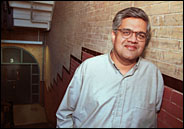Madhav Badami
Challenges of urban transportation
Cars and other motor vehicles have long been vilified in some quarters for damaging the air quality of our cities. Some experts claim that the increased motorization of urban areas has a way of discouraging non-motorized transportation, necessitating the need for yet more cars.
 |
|
Environmentally speaking, this vicious circle is bad news, but don't expect any counteracting policy to be simple, says Professor Madhav Badami of the School of Urban Planning and the McGill School of Environment.
"The politically correct thing might be to say, 'Oh, let's just do public transit, walking and cycling.' But let's face it, cars have their uses, in emergencies for example, or if you want to ferry a family and especially in winter. One has to be realistic and reasonable about these things and come up with a balanced approach that accommodates various choices for people with different kinds of needs.
"You need a well-integrated, multi-modal system that accommodates all these needs and possibilities, with the overall objective, over time, of minimizing the need for car use."
One of the reasons why transportation is a difficult issue to tackle effectively is because it goes beyond policy and depends on the myriad choices and needs people have.
"Pollution from vehicles depends on how people drive their vehicles, the speed at which they drive, how they maintain them, and whether on any given day they're going to take public transportation or hop into their cars. All of these choices are made by individuals, millions of them, on a daily basis. It's not very easy to control," he says.
Encouraging people who have the option of walking to work, for example, to actually walk there and not drive would be one challenge for a city like Montreal.
While social and cultural values play an important role, city planning is another factor. North Americans seem more reluctant to leave their cars in the garage than their European counterparts, but that may be because our cities are designed in a way that requires long-distance travel, with work places, hospitals and schools connected only by highways to residential areas.
"In Europe, cities developed long before the advent of the car. It was much easier to provide for walking and cycling and public transit. Governments need not have done that, but they have done that and there's a strong social consensus that supports those kinds of policies.
"So, you have much higher gasoline taxes [in Europe], it's more expensive to own and operate the vehicles, but you also have more viable options in terms of public transit and infrastructure for walking and cycling," says Badami, adding that while higher parking rates and, especially, gasoline taxes have proven very unpopular politically, a worldwide energy crisis would see them implemented in a hurry.
With OECD countries (primarily in North America and Europe) continuing to use excessive amounts of energy resources and the energy demand from developing countries expected to rise rapidly in the next few decades, a global crisis may not be that far off.
As part of the fieldwork for his PhD in environmental policy and planning at the University of British Columbia, Badami studied motorcycle use in New Delhi, India. New Delhi has a population of 15 million with an extra 600,000 -- almost the population of Calgary -- added every year.
Motorcycles and scooters, which make up two-thirds of all motorized vehicles in New Delhi, are "beasts of burden" for most people, often carrying entire families and groceries piled on one vehicle.
"They have no choice. They're stuck in a situation where, as motorization increases, it becomes more difficult for people without motor vehicles, and so you are forced also to buy one. And you go for the least expensive option," says Badami.
However, their fuel-inefficient engines make these cheap vehicles major air polluters. Furthermore, the city's blistering heat promotes the process whereby the evaporation from the fuel, a significant source of hydrocarbons, reacts with nitrogen oxides in the presence of sunlight to produce ground-level ozone, an irritant and crop-yield reducer.
The experience left Badami with a sense that policymakers in developing countries face a huge challenge as they try to put together initiatives that can deal with both the need for people to have access to transportation and the resulting threats to the environment.
In New Delhi and many other Asian cities, fuels like kerosene, referred to as the "poor person's fuel," are subsidized. Kerosene is commonly used for cooking and is often combined with gasoline or diesel to lower transportation costs.
"If you eliminate the kerosene subsidies, you reduce the air pollution in the transport sector, but because a very significant proportion of poor people, even in urban areas, rely on kerosene as a cooking fuel, the moment you remove these subsidies, you put it out of the reach of these poor people and you end up with other socioeconomic, environmental, heath and equity impacts. They might have to resort to firewood with very high indoor air pollution levels and deforestation," he says. "There are no easy solutions."
Badami's research at McGill will continue to focus on the multi-dimensional aspects of sustainable urban transportation policies, including alternative fuels and planning for non-motorized forms of transit. His research will also deal with other environmental issues such as energy conservation and solid waste management.

